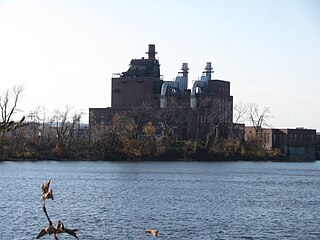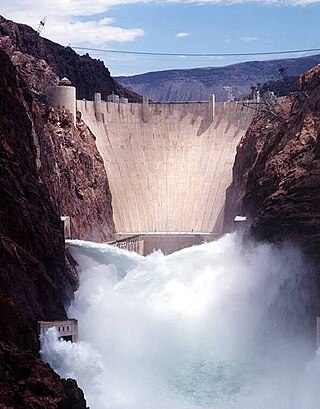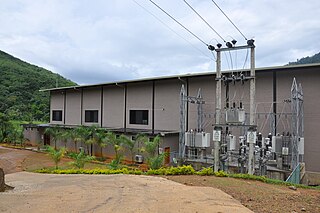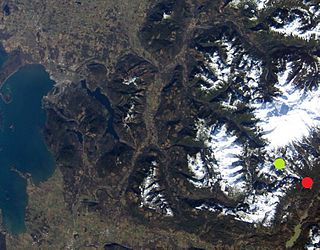
The electric power industry covers the generation, transmission, distribution and sale of electric power to the general public and industry. The commodity sold is actually energy, not power, e.g. consumers pay for kilowatt-hours, power multiplied by time, which is energy. The commercial distribution of electricity started in 1882 when electricity was produced for electric lighting. In the 1880s and 1890s, growing economic and safety concerns lead to the regulation of the industry. What was once an expensive novelty limited to the most densely populated areas, reliable and economical electric power has become an essential aspect for normal operation of all elements of developed economies.

Vermont Yankee was an electricity generating nuclear power plant, located in the town of Vernon, Vermont, in the northeastern United States. It generated 620 megawatts (MWe) of electricity at full power. The plant was a boiling water reactor (BWR), designed by General Electric. It operated from 1972 until December 29, 2014, when its owner Entergy shut down the plant. In 2008, the plant provided 71.8% of all electricity generated within Vermont, amounting to 35% of Vermont's electricity consumption. The plant is on the Connecticut River, upstream of the Vernon, Vermont Hydroelectric Dam and used the reservoir pool for its cooling water.

The Taum Sauk pumped storage plant is a power station in the St. Francois mountain region of Missouri, United States about 90 miles (140 km) south of St. Louis near Lesterville, Missouri, in Reynolds County. It is operated by Ameren Missouri.

Southern California Edison (SCE), the largest subsidiary of Edison International, is the primary electric utility company for much of Southern California. It provides 15 million people with electricity across a service territory of approximately 50,000 square miles. However, the Los Angeles Department of Water and Power, San Diego Gas & Electric (SDG&E), Imperial Irrigation District, and some smaller municipal utilities serve substantial portions of the southern California territory. The northern part of the state is generally served by the Pacific Gas & Electric Company of San Francisco. Other investor-owned utilities (IOUs) in California include SDG&E, PacifiCorp, Bear Valley Electric, and Liberty Utilities.

The Public Utility Regulatory Policies Act is a United States Act passed as part of the National Energy Act. It was meant to promote energy conservation and promote greater use of domestic energy and renewable energy. The law was created in response to the 1973 energy crisis, and one year in advance of a second energy crisis.

Folsom Powerhouse State Historic Park is a historical site preserving an 1895 alternating current (AC) hydroelectric power station—one of the first in the United States.

The Robert Moses Niagara Hydroelectric Power Station is a hydroelectric power station in Lewiston, New York, near Niagara Falls. Owned and operated by the New York Power Authority (NYPA), the plant diverts water from the Niagara River above Niagara Falls and returns the water into the lower portion of the river near Lake Ontario. It uses 13 generators at an installed capacity of 2,525 MW (3,386,000 hp).

The York Haven Dam is a low head, run-of-the river, dam and hydroelectric plant that is located on the Susquehanna River in the United States.
An independent power producer (IPP) or non-utility generator (NUG) is an entity that is not a public utility but owns facilities to generate electric power for sale to utilities and end users. NUGs may be privately held facilities, corporations, cooperatives such as rural solar or wind energy producers, and non-energy industrial concerns capable of feeding excess energy into the system.

Lennox Generating Station is a natural gas- and fuel oil-fired power station in Lennox and Addington County, Ontario, Canada. Owned and operated by Ontario Power Generation, it is situated on Highway 33 on the north shore of Lake Ontario, 2 miles (3.2 km) west of Bath, Ontario. It is the largest natural gas power station in Canada by installed capacity.

The West Springfield Generating Station, also known by its corporate name EP Energy Massachusetts, LLC, was a fossil-fuel-fired power plant located in West Springfield, Massachusetts. The station was a "peaking" facility, meaning that it primarily operates during peak electrical demand. The facility consisted of two 49-megawatt (MW) combustion turbine generators fueled by natural gas or ultra low-sulphur diesel fuel, one 18 MW jet turbine that was fueled by kerosene, and one 107 MW simple-cycle steam boiler unit burning no. 6 fuel oil, ULSD or natural gas. The station also had a small auxiliary boiler for process and building heat and an emergency back-up generator.

Hydropower policy in the United States includes all the laws, rules, regulations, programs and agencies that govern the national hydroelectric industry. Federal policy concerning waterpower developed over considerable time before the advent of electricity, and at times, has changed considerably, as water uses, available scientific technologies and considerations developed to the present day; over this period the priority of different, pre-existing and competing uses for water, flowing water and its energy, as well as for the water itself and competing available sources of energy have changed. Increased population and commercial demands spurred this developmental growth and many of the changes since, and these affect the technology's use today.
Natural Currents Energy Services, LLC is a developer and installer of hydro-electric systems. They produce scalable underwater turbines designed to capture energy from the tides of rivers and oceans. They hold Federal Energy Regulatory Commission (FERC) energy development permits at ten sites in the US, roughly 25% of the total tidal zone permits granted by FERC. The company has designed two models of turbine, the Red Hawk Tidal Power Generator and the Sea Dragon Tidal Turbine.
The Salina Pumped Storage Project is a 260-megawatt (350,000 hp) pumped-storage power station near Salina, Oklahoma. It is owned and operated by the Grand River Dam Authority (GRDA). Its construction was in response to growing power demands and a lack of dam sites on the Grand River. The first phase was completed in 1968 and the second in 1971. The upper reservoir for the power station is Lake W. R. Holway which was built on Saline Creek and the lower reservoir is Lake Hudson on the Grand River. During periods of lower power demand, water is pumped from Lake Hudson to Lake Holway and released back down through the pump-generators during periods of high energy demand.

The Rocky Mountain Hydroelectric Plant is a pumped-storage power plant located 10 miles (16 km) northwest of Rome in the U.S. state of Georgia. It is named after Rock Mountain on top of which the plant's upper reservoir is located. Construction on the plant began in 1977 and it was commissioned in 1995. After upgrades were completed in 2011, the plant has an installed capacity of 1,095 megawatts (1,468,000 hp). It is owned by both Oglethorpe Power and Georgia Power which have 75 percent and 25 percent stakes, respectively.

The Snoqualmie Falls Hydroelectric Plant is located just north of Snoqualmie in King County, Washington state, US. It is situated about 22 mi (35 km) east of Seattle. Located just below the Snoqualmie Falls, the power plant consists of two power houses, Plant 1 and Plant 2. Plant 1 was completed in 1899 and is located underground. It is the first completely underground hydroelectric power plant ever built in the world. Plant 2 was built in 1910 and is located along the right bank of the Snoqualmie River. Both plants receive water from a small reservoir created by a weir atop the falls. Plant 1 has an installed capacity of 13.7 MW and Plant 2 a capacity of 40.2 MW for a total installed capacity of 53.9 MW, enough to power 40,000 homes.

The Ellsworth Power House and Dam is a hydroelectric power generation facility on the Union River in Ellsworth, Maine. The dam, located just north of downtown Ellsworth, is also known as the Union River Dam, and impounds the river to create Leonard Lake, named for project's engineer, James Leonard. The powerhouse is a Renaissance Revival building located at the western end of the dam. The power plant, built in 1907, was one of the first peaking power plants built in the state, and the hollow concrete dam is one of the highest hollow buttress dams ever built, having been described as "the highest power dam in New England" in 1928. The facility was nominated for the National Register of Historic Places in 1985, where it is currently listed.

Denawaka Ganga Mini Hydro Power Project is a run of river mini hydro power project located in Ratnapura, Sri Lanka. The install capacity of the project is 7.2 MW and the annual generation is 25GWh. The generated energy is fed into the national electric grid of Sri Lanka.

The Koma Kulshan Project is a 13.3 MW run-of-the-river hydroelectric generation facility on the slopes of Mount Baker, a stratovolcano in Washington state's North Cascades. The project commenced commercial operation in October 1990, and is owned by a Covanta Energy–Atlantic Power joint venture. It supplies Puget Sound Energy via a Power Supply Agreement (PSA) contract. Its single turbine is a Pelton wheel supplied by Sulzer Escher Wyss.
St. Anthony Falls in Minneapolis, Minnesota, is the only natural falls on the Mississippi River. Since almost the beginning of settlement in the area by European descendants, the St. Anthony Falls have been used for waterpower. The first allowed settlers were at Ft. Snelling, where construction began in 1820. A sawmill was operating 1821 and a flour mill in 1823. As soon as the land at the sides of the falls became available it was purchased with the intent of using the waterpower of the falls. First lumber mills covered the falls, cutting lumber floated down the Mississippi. After 1870 flour mills started to dominate the area. From 1880 to 1930 the area was the number one flour producer in the US. In later years, some of the power came from steam, but in 1923 half of the waterpower used was for flour milling. Other industries have also used the waterpower.


















